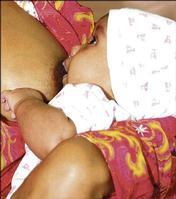
Exclusive breastfeeding is still touted as the best way to nourish a baby. However, as they become older, babies must be weaned. Parents must ensure this is done in a way that protects and improves the babies' health. - WINSTON SILL/FREELANCE PHOTOGRAPHER
FOR THE period 0-6 months, feeding the infant is not usually difficult for most mothers. If the infant is exclusively breastfed, all the mother concerns herself with is giving the baby a constant supply of breast milk. This is usually done through suckling the infant or by expression and having the milk fed by a caregiver when mother goes back to work.
Breast milk is sufficient in nutrients for growth, development and satiety up to six months, but as the infant develops and ages, breast milk can no longer be the sole form of nutrition. During weaning, infants indicate a desire for food by opening their mouth, leaning forward to indicate hunger and also leaning back or turning away to show disinterest or fullness. Before this stage, infants possess the type of reflex that allows them only to swallow liquid, but closer to six months they learn the oral and gross motor skills that help them to accept solids.
This transitional period should be handled carefully, as the introduction of solids should balance the nutrient needs with a variety of foods and textures, while encouraging feeding skills and development. The goal is to transit from a total liquid diet to a well balanced diet from the family pot.
NUTRIENT DENSE
During infancy the distribution of calories in the diet is approximately 40-50 per cent from fat and approximately 7-11 per cent from protein with the remainder from carbohydrates. When supplemental foods are added to the diet, this distribution can be affected, including vitamin and mineral intake. It is therefore very important that any solids fed to the infant be nutrient dense. Infants at six months who are consuming age appropriate solids, still rely on about eight per cent of their energy intake from breast milk or formula and twenty per cent from supplemental foods. This ratio changes as the infant ages and accepts more solids.
It is advised to introduce one new food at a time, preferably a single cereal mixed with breast milk or formula. One new food added one at a time makes it easier to identify foods which may cause allergic reactions. Strained fruits and vegetables and meats can be introduced at 6-7 months using the same principle of one new food at a time. After the food is introduced without problems, then they can be combined. Care must be taken to avoid highly spiced, sugary and salty foods.
This period demands patience on the part of the parents and caregiver. The growing infant will tolerate small amounts of new foods and should not be force fed. Parents should not be tempted to introduce juices at this stage, as the nutrient content of foods are important to the child's development. Mashed fruits are more calorie-dense, and juices can be high in sugar and excess water. Because infants have small stomachs and appetites, feeding excess juices can prevent them from consuming more nutrient and calorie-dense foods.
RISK OF IRON DEFICIENCY
Another problem faced by infants at this stage is the risk of iron deficiency anaemia caused by inappropriate liquids or large liquid volumes to the exclusion of solids. This includes strained meats, or other sources of iron fortified foods. Many infants who consume excess juices and even too much milk at the expense of caloric dense solids, experience what is referred to as failure to thrive, meaning their growth and development pattern is slowed.
Infants should also be encouraged to develop independence in feeding at this stage. They should be encouraged to self-feed soft finger foods, sip from cups, hold their cups independently, and control feeding by indicating fullness.
Rosalee M. Brown is a registered dietician/nutritionist; email: yourhealth@gleanerjm.com.



